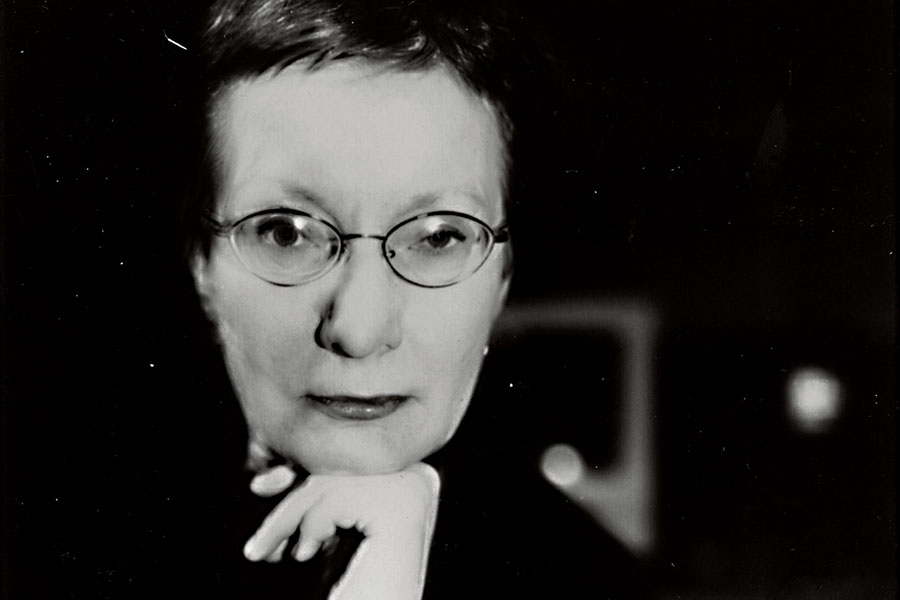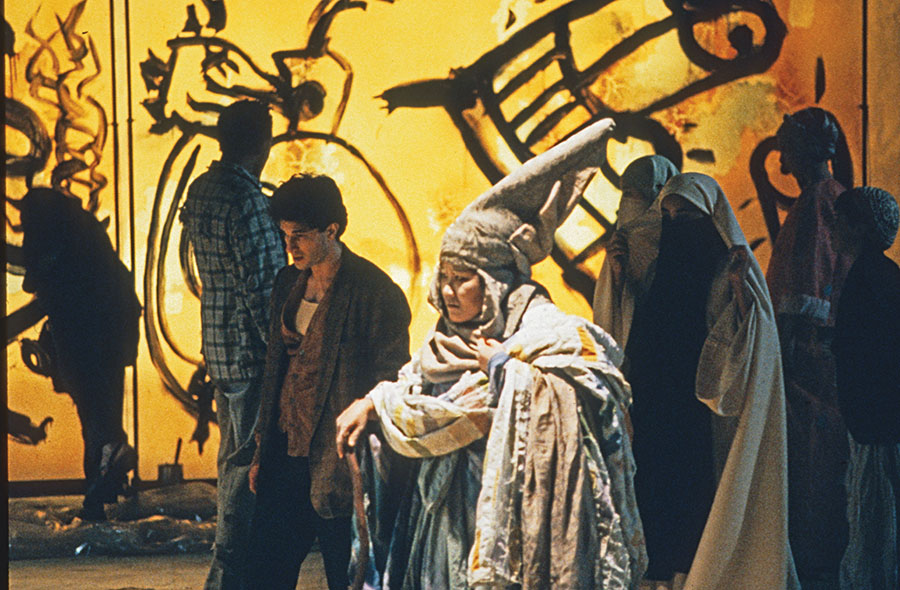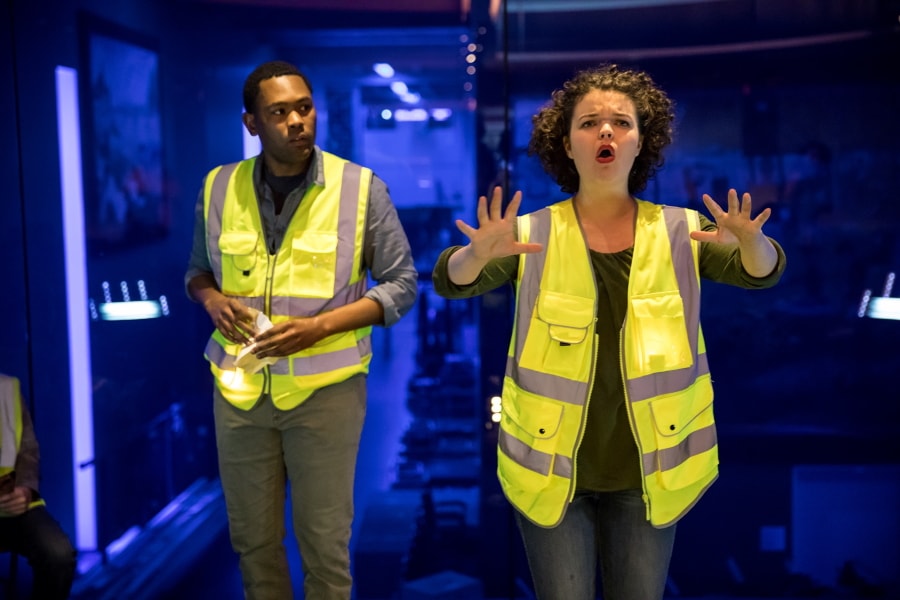Messengers in Greek tragedy are tasked with bearing witness to the unthinkable and of passing on their eyewitness accounts. Messenger speeches are not unlike stories of atrocity told to Truth and Reconciliation Commissions, or stories told by designated survivors of the Holocaust, whose responsibility was to survive precisely so they could describe what they had seen with their own eyes in the hope that it would never happen again: Nunca mas.
Indeed, “I will tell you everything” is a constant refrain in Bad News! I was there…, a new site-specific processional performance composed of messenger speeches from Greek tragedy compiled by director JoAnne Akalaitis and coming to New York City’s NYU Skirball Center, Sept. 6-8. There’s the speech by which Medea learns of the effect of her poisoned robe on Jason’s bride; the one in which we learn of Iphigenia’s sacrifice; another about the slaughter of the entire Persian army; and one about Pentheus’ death and dismemberment by the Bacchae and his own mother.
Of course, the messenger is also a storyteller—one charged with passing on not only the facts, but their affective impact. In doing this they must relive the horror, embody it, share it, and evoke the audiences’ emotional responses. “But there is a cost/In telling too, a double price of tears./I was crying when Polyxena died, and I will cry again while telling you./but listen,” goes one passage of Bad News! Messengers, then, are quintessential actors. Or vice versa.
I tell these stories
Suffering twice: feeling terrible pains
In telling it, suffering again what was already suffered.
These sorrows are not just a tale that’s told
They live in time out of mind.
Messengers link the horrors we would like to keep off the stage entirely with what is seen, heard, and understood. The word “theatre” is derived from the Greek “theatron,” or place of seeing. And so theatre is literally a place where we see, face, and—as Akalaitis puts it—“negotiate what may be fundamentally non-negotiable.” Akalaitis notes that the phrase “I was there,” often repeated in the play, “is a refrain heard every day on the news, often followed by: How can this happen? What’s wrong here? What should we do?”
At one point in Bad News! a messenger from The Persians steps forward and delivers this speech, which could have been written yesterday:
We are what is left of your Persian army.
Have we been chosen
out of everyone
somehow deserving
to have the world smash up and fall on us?
or have the last days come in our lifetime?
It’s a hard fate, whether we’ve lost the sun
Or driven it away.
Let’s stop lamenting. Let’s not be frightened.
Happiest are those who die quickly.
Only a handful of us made it through all of that and we cannot look at each other.
We have seen too much.
You’d have to be really greedy for life
if you didn’t want to die when the whole world’s dying with you.
We were there.
Bad News! began five years ago, around the time Akalaitis called her friends and announced that she was “giving up theatre. It doesn’t seem to be feeding me or the society.” Soon after her announcement, the executive director of Poets House in New York City invited Akalaitis to create a piece for their new space. When she looked at the courtyard, the idea struck her: “I want to do a piece called Bad News! about messenger speeches from Greek plays.” Akalaitis says she had never thought about it before. “The idea for this piece came from the gods,” she muses.
While that is certainly possible, it is equally likely that it arose from Akalaitis’s deep study of Greek tragedy over her 50-year career in the theatre, and from her work with classicists, not to mention her perceptions of the current political moment. To create Bad News!, she met with Greg Taubman, a classicist from Princeton, and colleagues Kate Atwell and Ashley Tata, to weave together texts from various tragedies, including W.B. Yeats’s version of Oedipus Rex, Ellen McLaughlin’s version of The Persians, Paul Schmidt’s translation of Racine’s Phaedre, Anne Carson’s Antigonick, and Nicholas Rudall’s translation of Euripides’ Medea. Akalaitis gathered a group of actors for a single day of rehearsal, and staged the piece in the courtyard of Poets House as part of the River to River Festival in 2013.
After a reading at New York Theatre Workshop in 2015, Akalaitis felt that “something like an oratorio form was right for the material,” so she invited longtime collaborator Bruce Odland (who had worked with her on The Iphigenia Cycle at Chicago’s Court Thea-ter in 1997) to join her for a 10-day workshop at Bard College, where, with students, they constructed the basic form of the current piece. Bad News! divides the audience into several groups, each of whom follow a guide from scene to scene, walking through—one might call it processing, in both senses of the word—the emotional and intellectual world of the play. Bad News! had its official premiere at the Guthrie Theater in Minneapolis in June 2018, with lighting by Jennifer Tipton, where, as Akalaitis puts it, it “woke up the lonely, often empty, public spaces common to most large institutions.”
For the time was
For the time that will be
For the time that was yet to pass
Where can I stop?
Where can it step?
Where can I turn?

So has Akalaitis, a key figure in 20th-century U.S. theatre, come back to it after renouncing it five years ago? Her résumé stretches back to the co-founding of Mabou Mines in 1970, and her work since has taken her to most of the nation’s major regional theatres, often at propitious moments. In 1999 she staged a stunning production of Trojan Women at D.C.’s Shakespeare Theatre Company just as the U.S. Congress was debating whether or not NATO should engage to halt the Muslim genocide in the former Yugoslavia. Her 1986 production of The Balcony was framed by the guerrilla warfare in Nicaragua and El Salvador. 1987’s Leon and Lena (and Lenz) made unflattering references to one of the corporate donors at the theatre where it was presented, the Guthrie. In Bad News! Akalaitis draws a parallel between messenger speeches and contemporary media coverage of current events.
Her work has always combined what the Star Tribune in its review of Bad News! called “magisterial beauty” with incisive political commentary. And while each production she directs is unique, most contain the following elements: a slow-motion dance (often used as the prologue or physical “overture”), live music (usually composed specifically for the piece), an overlapping of daily life with theatrical reality by having the play begin while the audience is still entering the space, disjunctive time elements, a symbolic gestural vocabulary, and the juxtaposition of image, gesture, text, music, lighting, and costume to create a theatre of the subconscious. All her productions involve the creation of community, not only backstage among the company, but in the house: For The Screens at the Guthrie in 1989, Akalaitis asked that actors decorate the windows of the theatre’s lobby with some of the artwork they drew on screens during the performance, and audiences broke bread together at intermission.
These elements are present, in differing ways, in Bad News! Akalaitis says she is now excited by site-specific theatre, by “theatre where there are no cues, and no scenery (other than the site). No lighting except for homemade or handheld lights. I love the idea of no tech.” Her longtime interest, developed more fully than ever in Bad News!, is in the polis coming together to share an experience and negotiate its ramifications.

Bad News! has marked a departure from, or condensation of, Akalaitis’s usual rehearsal process—or at least what I observed when I was assistant director on The Screens back in 1989. On the first day of rehearsal for that piece about the Algerian war for independence, the Guthrie company read through the first half of Jean Genet’s play, watched a BBC interview with Genet, were introduced to the costume and set designs, and began to explore what I call the “dramaturgy table”: a collection of books, recordings, and images. Akalaitis had assembled the stories of Paul Bowles and Mohammad Mrabet, Frantz Fanon’s The Wretched of the Earth, Edward W. Said’s Orientalism, Jean Genet’s The Thief’s Journal, E. Mansell Pattison’s The Experience of Dying, a picture book about the French Foreign Legion, records and tapes of West African music, and photos of Morocco and Algeria. In the first week of rehearsal several guests spoke to the company: Catherine B. Asher from the University of Minnesota gave a slide lecture on Islamic Art and Architecture, Maamar Benkraouda and Abdulrahman Alharbi gave an explanation and demonstration of Islamic prayer, and Akalaitis read excerpts from Genet’s Letters to Roger Blin to the company. Akalaitis screened The Battle of Algiers, Querelle, and Days of Rage. The director also brought an enormous number of unstructured ideas into the room, creating a collage of images, sounds, and ideas for the actors to draw on.
This process encouraged actors to make—and make use of—their own associations with the material. The question “what does this play mean” was replaced by the question “what does this production evoke” and “what does it do.” Akalaitis thus freed herself and her cast to explore things that made intuitive sense but were difficult to explain in words, and to explore unconscious or subconscious intuition rather than conscious reason. The late Ruth Maleczech, an actor and longtime collaborator from Mabou Mines, once called Akalaitis “a unique breed who continues to [dream the play] throughout the process” rather than giving in to all the practical questions that arise during rehearsal. “That dreaming,” Maleczech noted, “gives rise to things like metaphor and inexplicable conjunctions of light and costume that would be difficult to rationalize, but that feel right.”
Akalaitis always took full advantage of the regional theatre’s rehearsal process, starting each rehearsal day with extensive physical warmups, dancing, slow motion movement, and gestural work. But she is now excited by the notion of a condensed eight-day rehearsal process. “When actors know it’s on them to get it right and work together, both in terms of [the] a cappella singing [required of the piece] and coordinating with each other in different parts of the building, they are remarkably creative.” She uses some of the same techniques in her new rehearsal, but in a much more distilled fashion, so that the actors become what Artaud called an “athlete of the emotions.” And while the rehearsal process for Bad News! has not formally incorporated lectures, Akalaitis still makes use of a dramaturgy table and invites the actors to “dream the play” with her.
This dreaming allows for politics, music, physical gesture, and raw emotion to blend into something that is larger than each element on its own. As Rohan Preston, who reviewed last year’s Guthrie production, wrote: “The mixture of voices shows that the audience and the storytellers are part of a bigger world—and history. The show is suffused with incantatory, multi-harmony singing, music that’s both gorgeous and functional. The songs that swell up and fill the theatre sound like things you might hear in a temple, even as they are cues for the guides to take the audience from station to station.”
Bad News! ends with a public gathering. As the audience is guided through the performance, they are invited to leave their own pieces of bad news in boxes placed throughout the theatre. At the end of the play, people pick out the anonymous notes from the boxes and read them aloud, becoming active participants in both the production and the conversation it is designed to generate. As Akalaitis puts it: “The bad news people write about is not necessarily surprising or even shocking, but it may fit into a template or workshop that the Greeks created for spectators to consider an unstable, open-ended, disorienting, tragic world which continues to speak so urgently to all of us.”
Erin B. Mee is the author of numerous books and articles, the artistic director of This Is Not a Theatre Company, and a professor of drama at New York University’s Tisch School of the Arts.





